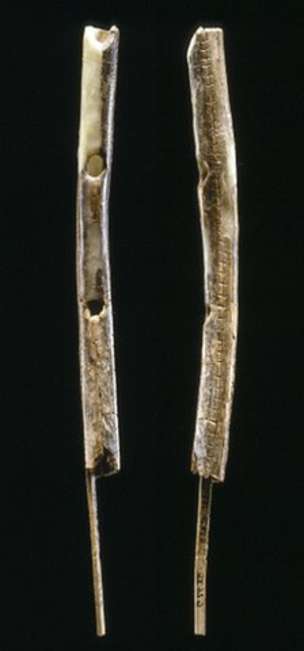25 May 2012 Last updated at 07:03 ET| BBC – NEWS Science & Environment
Researchers have identified what they say are the oldest-known musical instruments in the world.

The flutes, made from bird bone and mammoth ivory, come from a cave in southern Germany which contains early evidence for the occupation of Europe by modern humans –Homo sapiens.
Scientists used carbon dating to show that the flutes were between 42,000 and 43,000 years old.
The findings are described in the Journal of Human Evolution.
A team led by Prof Tom Higham at Oxford University dated animal bones in the same ground layers as the flutes at Geissenkloesterle Cave in Germany’s Swabian Jura.
Prof Nick Conard, the Tuebingen University researcher who identified the previous record-holder for oldest instrument in 2009, was excavator at the site.
He said: “These results are consistent with a hypothesis we made several years ago that the Danube River was a key corridor for the movement of humans and technological innovations into central Europe between 40,000-45,000 years ago.
“Geissenkloesterle is one of several caves in the region that has produced important examples of personal ornaments, figurative art, mythical imagery and musical instruments.”
Musical instruments may have been used in recreation or for religious ritual, experts say.
And some researchers have argued that music may have been one of a suite of behaviours displayed by our species which helped give them an edge over the Neanderthals – who went extinct in most parts of Europe 30,000 years ago.
Music could have played a role in the maintenance of larger social networks, which may have helped our species expand their territory at the expense of the more conservative Neanderthals.
The researchers say the dating evidence from Geissenkloesterle suggests that modern humans entered the Upper Danube region before an extremely cold climatic phase at around 39,000-40,000 years ago.
Previously, researchers had argued that modern humans initially migrated up the Danube immediately after this event.
“Modern humans during [this] period were in central Europe at least 2,000-3,000 years before this climatic deterioration, when huge icebergs calved from ice sheets in the northern Atlantic and temperatures plummeted,” said Prof Higham.
“The question is what effect this downturn might have had on the people in Europe at the time.”



